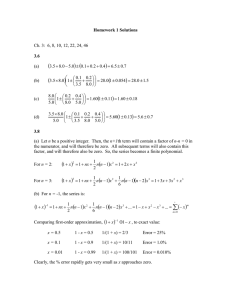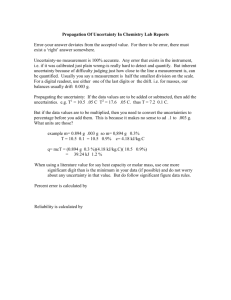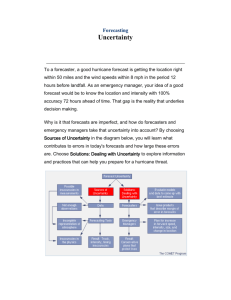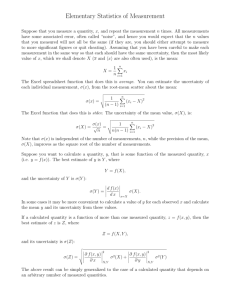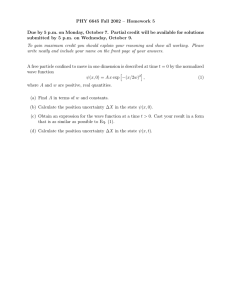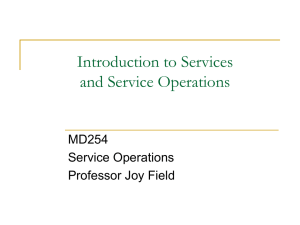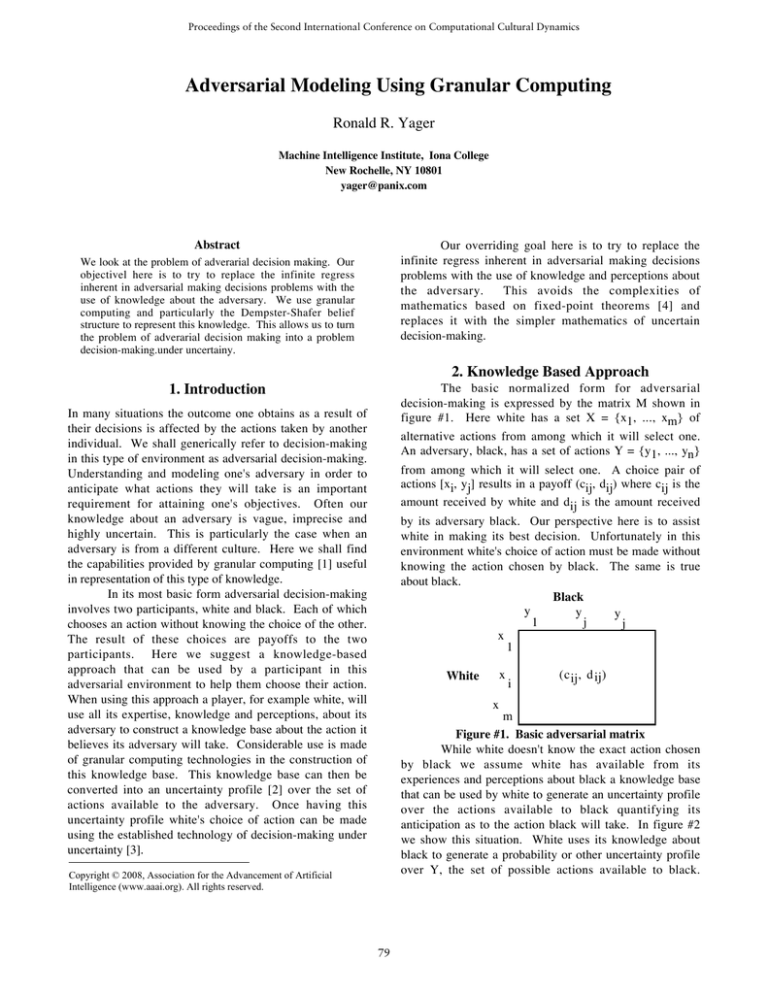
Proceedings of the Second International Conference on Computational Cultural Dynamics
Adversarial Modeling Using Granular Computing
Ronald R. Yager
Machine Intelligence Institute, Iona College
New Rochelle, NY 10801
yager@panix.com
Abstract
Our overriding goal here is to try to replace the
infinite regress inherent in adversarial making decisions
problems with the use of knowledge and perceptions about
the adversary.
This avoids the complexities of
mathematics based on fixed-point theorems [4] and
replaces it with the simpler mathematics of uncertain
decision-making.
We look at the problem of adverarial decision making. Our
objectivel here is to try to replace the infinite regress
inherent in adversarial making decisions problems with the
use of knowledge about the adversary. We use granular
computing and particularly the Dempster-Shafer belief
structure to represent this knowledge. This allows us to turn
the problem of adverarial decision making into a problem
decision-making.under uncertainy.
2. Knowledge Based Approach
1. Introduction
The basic normalized form for adversarial
decision-making is expressed by the matrix M shown in
figure #1. Here white has a set X = {x1, ..., xm} of
In many situations the outcome one obtains as a result of
their decisions is affected by the actions taken by another
individual. We shall generically refer to decision-making
in this type of environment as adversarial decision-making.
Understanding and modeling one's adversary in order to
anticipate what actions they will take is an important
requirement for attaining one's objectives. Often our
knowledge about an adversary is vague, imprecise and
highly uncertain. This is particularly the case when an
adversary is from a different culture. Here we shall find
the capabilities provided by granular computing [1] useful
in representation of this type of knowledge.
In its most basic form adversarial decision-making
involves two participants, white and black. Each of which
chooses an action without knowing the choice of the other.
The result of these choices are payoffs to the two
participants. Here we suggest a knowledge-based
approach that can be used by a participant in this
adversarial environment to help them choose their action.
When using this approach a player, for example white, will
use all its expertise, knowledge and perceptions, about its
adversary to construct a knowledge base about the action it
believes its adversary will take. Considerable use is made
of granular computing technologies in the construction of
this knowledge base. This knowledge base can then be
converted into an uncertainty profile [2] over the set of
actions available to the adversary. Once having this
uncertainty profile white's choice of action can be made
using the established technology of decision-making under
uncertainty [3].
alternative actions from among which it will select one.
An adversary, black, has a set of actions Y = {y1, ..., yn}
from among which it will select one. A choice pair of
actions [xi, yj] results in a payoff (cij, dij) where cij is the
amount received by white and dij is the amount received
by its adversary black. Our perspective here is to assist
white in making its best decision. Unfortunately in this
environment white's choice of action must be made without
knowing the action chosen by black. The same is true
about black.
Black
y
y
y
1
j
j
x
1
x
White
x
i
(c ij , d ij )
m
Figure #1. Basic adversarial matrix
While white doesn't know the exact action chosen
by black we assume white has available from its
experiences and perceptions about black a knowledge base
that can be used by white to generate an uncertainty profile
over the actions available to black quantifying its
anticipation as to the action black will take. In figure #2
we show this situation. White uses its knowledge about
black to generate a probability or other uncertainty profile
over Y, the set of possible actions available to black.
Copyright © 2008, Association for the Advancement of Artificial
Intelligence (www.aaai.org). All rights reserved.
79
Let S = {S1, ..., Sq} be a collection of ADMS's
generated by white from among which white perceives
black will select its actual decision-making strategy
(policy). Here white is assuming it knows and understands
the possible strategies available to black.
By
understanding a strategy Sj we mean that given the payoff
White then uses this uncertainty profile on Y in
conjunction with its own decision objectives to select its
action. What must be emphasized here is that white's
knowledge base is owned and constructed by white with
the purpose of helping it make a better decision. Our
objective in this paper is to provide tools to help white
represent and use its knowledge base.
White's
Decision Making
Attitude
Uncetainty
Profile
Over
Black's
Actions
Whites
Knowlegde
Base
about Black
White's
Action
Choice
Figure #2. Basic Approach
matrix M white is able to determine an associated welldefined uncertainty profile over the set Y if black uses
strategy Sj. Understanding a strategy also implicitly
Here we shall consider one type of knowledge base that
can be constructed by white. Fundamental to this type of
knowledge base is the concept of an adversarial decisionmaking strategy, ADMS. By an ADMS we mean some
procedure, objective, process or algorithm that black can
use to select its action from Y. In order to provide some
intuition we describe some simple ADMS, more complex
ones will be discussed later. One simple strategy is for
black to randomly choose an action from Y. Another
strategy that black can use is to treat the decision matrix in
figure #1 as an example of decision-making under
ignorance. In this case black will select the action yi that
gives it the maximum payoff, that is it selects the
implies specification of the mechanism black uses to select
the action having the associated uncertainty profile.
Fundamental to our approach is the assumption
that white uses its totality of knowledge about black to
construct a knowledge base over the set S reflecting which
strategy from S that black will use to select its action.
More specifically we shall assume that white's knowledge
about how black will make its choice is expressed as a
generalized uncertainty profile G over the space S
indicating its anticipation of the strategy to be used by
black for selecting its action from Y.
In the work that follows our point of departure is
the availability of an uncertainty profile G over the space
of possible strategies S. We are not concerned here with
the process of how white constructs the G from its totality
of knowledge about black, however we appreciate the
importance and difficulty of this task. In point of fact our
formulation of white's knowledge about black's choice
procedure over the space S of strategies instead of directly
in terms of Y is a concession to the difficulty of
formalizing whites knowledge. By using objects of larger
granularity, the strategies, rather then actions themselves,
we are allowing for less precision, greater granularity, in
the formalization of whites knowledge.
Let us now see how this structure of having an uncertainty
profile G can be used to support a decision-making
methodology for white. For any strategy Sk, using the
payoff matrix M, white can generate an uncertainty profile
m
action y j* such that dij* = Max j[ ∑ dij ], the action with
i=1
the largest total payoff. Another strategy that black can
use is to consider the matrix in figure #1 from a game
theoretic point of view and locate the Nash equilibrium [4].
We should note that another strategy could be to directly
select an action yk from Y. Thus the actions themselves
can viewed as special strategies, so called atomic
strategies.
We emphasize that by a strategy we mean some
well understood procedure for selecting an action by black.
We note that a strategy can be deterministic, it always
leads to some action for the same payoff matrix. A
strategy can also be non-deterministic, the final choice of
action may be random, it can result in different actions in
the same situation.
80
Hk over Y indicating the anticipation of yj being black's
action under Sk. Using its knowledge base with respect to
to obtain H. In the light of this we are often faced with a
conflict between using a sophisticated uncertainty
representation to better model our knowledge and the
ability to perform the required operation with the
representation used.
black's choice of strategy, the uncertainty profile G over S,
white can combine the associated uncertainty profiles, the
Hk, to obtain a unified uncertainty profile H over Y.
White can then use this unified uncertainty profile over Y
in coordination with M to make its selection of action from
X. In the following figure #3 we provide a schematic with
this process.
Whites Knowledge and Perceptions about Black
Perceived Strategies
open to Black
Payoff Matrix M
Action Associated
with a strategy
Uncertainty Profile
Over Strategy Choice
Uncertainty Profile
Over Black Actions
Whites Decision Attitude
White's Action
Choice
Figure #3. Knowledge Based Adversarial decision-making
3. Uncertainty Profiles Using DempsterShafer Belief Structures
One framework for representing uncertain
knowledge is the Dempster-Shafer belief structure [5].
Formally a Dempster-Shafer belief structure is a mapping
In some situations the ability to implement all the required
operations are not available. This particularly occurs with
the operation of combining the individual Hk guided by G
81
m: 2S → [0, 1] such that: 1. m(∅) = 0 and 2.
∑
particular given a D-S belief structure it can be shown that
for any subset A of S that Bel(A) ≤ Prob(A) ≤ Pl(A). In
this context we call Pl(A) and Bel(A) the upper and lower
probabilities. Thus D-S the structure can be used to model
situations in which white's assessment of the probabilities
associated with black's strategy selection is imprecise.
Rather then being specific values they are intervals.
We shall find the following slightly more general
expression of Bel(A) and Pl(A) useful. Let D = A ∩ B and
D(z) indicate the degree of membership of the element z in
the intersection of A and B. Using this we define the
possibility of V lying in the set A given that it is in the set
B as Poss[A/B] = Maxz[D(z)]. We also define the degree
m(B) =
B⊆ X
1. Using the terminology of Shafer [6] we call a subset B
for which m(B) > 0 a focal element. If we have r focal
elements we shall denote them Bj for j = 1 to r. Using this
notation
∑
B⊆ X
r
m(B) = 1 becomes ∑ m(B j ) = 1.
j=1
Two important concepts associated with a D-S
structure are the measures of plausibility and belief. For
any subset A of we define these respectively as
Pl(A) =
∑
B j ∩A≠∅
Bel(A) =
∑
B j ⊆A
of certainty that V lies in A given that it is known to lie B
as Cert[A/B] = 1 - Poss[ A /B]. Using these concepts we
can express
m(B j )
m(B j ) .
Pl(A) =
∑
Poss[A/Bj] m(Bj
Bj
It is well known for A ≠ ∅ that Pl(A) ≥ Bel(A).
Let us provide some semantics for the formal
structure. A prototypical interpretation for the D-S belief
structure is the random set model. Here we have a random
experiment in which the outcome instead of being an
element is a subset. In this random experiment m(Bj) is
the probability that the outcome is in the set Bj. In this
Bel(A) =
∑
Cert[A/Bj] m(Bj)
Bj
Thus if m(B) is seen as the probability of the strategy lying
in Bj then Pl(A) is the expected possibility of black's
strategy lying in A and Bel(A) is the expected certainty of
the strategy lying in A. As we noted these can be seen as
upper as lower bounds on the probability that the selected
strategy will be in A. One important benefit of this
generalization is that it allows us to have focal elements
that are fuzzy sets.
Since we are using our uncertainty model to
represent white's perceptions about the strategy that black
will use the D-S model of uncertainty is be particularly
useful in that it allows us to express these perceptions in a
very granular way [7]. Using these structures we can allow
white to represent this belief about white's choice of
strategy as imprecisely as it needs. Thus white is not
forced to be more precise then it feels justified, for
example it can use imprecise intervals to express its
probabilities.
In the following we shall indicate some special
cases of D-S belief structure and discuss the types of
information they represent. Complete certainty about the
value of the variable V can be modeled using a D-S belief
structure with one focal element B1 such that B1 = {Sk}
and m(B1) = 1. Here white's perception is that the strategy
to be used by black is Sk. At the other extreme is the case
framework additional uncertainty stems from the fact that
we don't know how the actual element is selected from the
set chosen. In our context of using this to represent
knowledge about which is the true value of V we can
interpret this as follows. We believe with probability
m(Bj) that the elements will be selected from the subset Bj
of S but we don't know how the actual element is selected
from Bj. For example white may believe that there is a
50% chance that black will use a strategy based on viewing
the problem just considering the payoffs it will receive, as
one of decision-making under ignorance, without being
able to make any distinction with regard to blacks
preferences among the strategies in this class.
Another interpretation of the D-S formalism is as a
generalization of the idea of a probability distribution.
With an ordinary probability distribution we have a
collection of q probability weights pj where the pj are nonnegative and sum to one. These weights are assigned to
individual elements in the underlying space S. In the D-S
framework these weights are assigned to subsets of S, the
focal elements, rather individual elements. We don't know
how the weights are distributed among the elements in the
subset to which they are assigned.
Under this generalized probability interpretation
the Dempster-Shafer model can be used to represent
situations in which we have imprecise probabilities [2]. In
where we are completely uncertain, this can be modeled
with D-S structure having one focal element, B1 = S and
m(B1) = 1. More generally both of these can be seen as
special cases of a situation where white believes that the
82
strategy that will be selected is from some subset B. In this
case we again have one focal element B1 = B with m(B) =
combining these individual perceptions to get an overall
uncertainty profile is to use Dempster's rule of combination
[5].
1. An ordinary probability distribution can be modeled as
a special case of D-S belief structure. Here with S = {S1,
..., Sq} we define our focal elements as singletons, Bj =
{Sj} for j = 1 to q and assign m(Bj) = pj. A possibility
4. Decision-Making with Belief Structures
If we use Dempster-Shafer belief structure to
provide a uncertainty profile one task that we have to
address is the determination of the expected value under
this type of representation of uncertainty. We now
describe a methodology for determining an this expected
value introduced in [8]. Let R be a random variable.
Assume our knowledge about the value of this random
variable is expressed via a D-S belief structure m having
focal elements Bk = 1 to r. Assume each focal element Bk
consists of a collection of values zj/ where j = 1 to |Bk|.
k
Our problem is to determine the representative or expected
value of R in this situation.
As discussed in [8] when using the D-S model we
are assuming a random selection of focal element with
m(Bk) the probability of selecting Bk. Assume we can
obtain for each focal element Bk an associated
representative value, Val(Bk). Using this value we can
obtain the overall valuation of the variable R as the
expected value of this individual values,
distribution can also be represented as a D-S belief
structure.
Another important special case is where we have a
D-S belief structure such that m(B) = α and m(X) = 1 - α.
This can provide is model of a situation in which white
believes that the probability that black will select its
strategy from B is at least α.
Closely related to the preceding D-S structure
where m(B) = α and m( B ) = 1 - α. In this case we see
Prob(B) = α. Here we have a model of whites perception
that the probability that black will select its strategy from B
is exactly α.
We note that within this framework we can allow
the use of fuzzy sets. Thus we can allow the focal
elements to be fuzzy subsets. This becomes a special case
of what Zadeh called perception based granular
probabilities [7]. In particular if the focal elements are
fuzzy and A is a fuzzy subsets of S we have
Pl(A) = ∑ Poss[A/Bj]m(Bj)
r
Val(R) =
Bj
where
Val(Bk) m(Bk).
The issue now becomes the determination of the
representative value associated with each of the focal
elements. Since we have no information as to how the
value will be selected once a focal element is selected the
determination of this value can be seen to be equivalent to
the valuation of an alternative in decision-making under
ignorance. In this case as discussed in [8] we must impose
a decision attitude. The choice of decision attitude leads to
formulation of Val(Bk). For example an optimistic attitude
will lead us to the formulation, Val(Bk) = Maxj[zj/k], the
Poss[A/Bj] = Maxi[A(Si) ∧ Bj(Si)].
Here A(Si) and Bj(Si) are the membership grades of Si in
A and Bj respectively and ∧ is the Min operator.
Furthermore we have Bel(A) =
∑
k=1
∑
Cert[A/Bj]m(Bj)
Bj
where Cert(A/Bj) = 1 - Poss[ A /Bj]
As we have indicated the D-S belief structure is
very useful for modeling white's perceptions about the
strategy that black will use. However there is another
useful feature that the D–S approach has for obtaining a
representation of the uncertainty profile over black's choice
of strategy as seen by white. In addition to providing for
the ability to model whites perceptions of the strategy to be
used by black a very important feature of the D-S
framework is that it has a very convenient methodology for
combining these individual perceptions to get the overall
uncertainty profile capturing all of whites knowledge.
Assume mi for i = 1 to L are a collection of D-S structures
over S. For the belief structure mi let Bij, j = 1 to ηi be its
associated focal elements. Here each mi can correspond to
largest value in Bk. At the other extreme is a pessimistic
attitude here the formulation is Val(Bk) = Minj[zj/k], it is
the smallest value in Bk. Intermediate to these is a neutral
|B |
k
1
decision attitude where Val(Bk) =
Z j/k , the
∑
| Bk |
j=1
average of the elements in Bk.
Using the OWA aggregation operator Yager [8]
suggested a more general approach which unifies these
different formulations. Let wi/k be a collection of |Bk|
non-negative weights summing to one. We can view these
weights as a vector Wk of dimension |Bk| and denote is as
the weighting vector associated with Bk. Let bi/k be the
an perception that white has regarding black's selection of
strategy. The most commonly used approach for
83
ith largest of the elements in Bk. Using the OWA operator
based method of calculating the Val(Bk) we get
2. Using this we obtain a weighting vector of
dimension |Bk| for each focal element. This requires
solving the preceding MP problem for each focal element.
3. We can then use these weights to obtain the
valuation Val(Bk) for each focal element as Val(Bk)
|Bk |
Val(Bk) =
∑ wi/k b i/k .
i=1
|Bk |
We observe that if w1/k = 1 and wi/k = 0 for i ≠ 1
then we get the maximum as the valuation. If we select
wn/k = 1 and wi/k = 0 for i ≠ n then we get the minimum
1
for all i then we get the
as the valuation. If wi/k =
| Bk |
=
α =
character
i=1
4. Finally we calculate the overall expected value
as
r
Val(m) =
1
∑ w i/k (| Bk | −i) . It can be shown that α lies
| Bk | −1
5. Strategies
i=1
in the unit interval. We further note that if we have the
optimistic decision maker where w1/k = 1 then we get α =
Here we discuss the some different strategies that
black can use to select its action. Perhaps the most
rudimentary strategies that black can use are those in
which it uses no other information then the set Y. The
most basic of these is where black randomly selects an
element from Y. Here the strategy results in Prob(yj) =
1.
If we have the neutral decision maker where
1
wi/k =
for all i then we get α = 0.5. For the pure
| Bk |
pessimist where wn/k = 1 we get α = 0. We see that
attitudinal character provides a scale indicating the
optimism-pessimism of the decision maker.
Inversely we can obtain a set of weights of
cardinality |B | from a given value of α by solving the
k
following mathematical programming problem. Here we
let |Bk| = n
1/m, where m is the number of elements in Y. Another
example of this type of strategy is where black selects what
it did last time. In this case if yr indicates what it did last
time then Prob(yr) = 1 and Prob(yj) = 0 for j ≠ r. Related
to this is the case where black does something different
than it did last time. Here Prob(yr) = 0 and Prob(yj) =
1
for j ≠ r. More generally here we consider
m −1
strategies that are based simply on some properties of the
action itself independent of what alternatives are open to
white.
Another class of strategies that black can use are
those which simply use the payoff matrix M and make no
supposition regarding the action that will be taken by
white. In this case black is using what is called in the
literature decision-making under ignorance. Within this
class a number of special cases are well known. One is the
Maxi-Min strategy. Using this strategy black determines
its action using the following procedure. For each action
open to it, each column of the matrix M, it will calculate
the smallest payoff it can receive. Let us denote these as
Dj = Mini[dij]. Under this strategy the action that will be
taken by black is to select y such that yj* = Maxj[Dj]. In
the case of Maxi-Min strategy white is able to uniquely
determine the action to be taken by black.
n
wi ln(wi)
i=1
n
Such that: 1.
1
∑ wi (n − i)
n −1
i=1
n
2.
Val(Bk) m(Bk)
k=1
α , which is defined as
∑
∑
We note that for the special but important cases
when α= 1, 0.5 or 0 we can directly obtain the weight
without having to solve the MP problem.
|Bk |
Max H(W) = -
Here b i/k is the ith largest element in the
focal element Bk.
neutral valuation.
Yager [8] used this formulation to provide an even
more general method for the determination of Val(Bk).
Here associated with the weighting Wk a feature called its
attitudinal
∑ wi/k b i/k .
∑ wi = 1
i=1
3. 0 ≤ wi ≤ 1
We now can summarize our approach to obtaining
an expected value in the case of a Dempster- Shafer
uncertainty profile. Assume the payoff structure is
expressed in terms of a Dempster- Shafer belief structure m
with focal elements Bk, k = 1 to r.
1. The decision maker provides its desired degree
of optimism α ∈ [0, 1].
84
We shall refer to these three different underlying
decision imperatives that can be associated with black
respectively as acquisitive, malicious and competitive.
Another class of strategies open to black are those
in which in the process of choosing its action in addition to
using the information contained in M black reflects upon
what action might be taken by white. The field of Game
Theory is very much concerned with this type of problem.
The possibilities here are very diverse and rich and are
strongly context dependent. Investigating and describing
these in detail is beyond our current scope, however we
shall just mention one important example of this. Consider
the case where black's objective is to maximize the
difference between its payoff and that of white, it wants to
Max∆ij. In this case black can view this situation as a zero
Another strategy in this class is one where black
would calculate for each action yj the sum of the payoffs to
m
it, Dj =
∑
dij. Using this black would then select the
i=1
action that maximizes this sum.
Another strategy within this class is the Maxi-Maxi
strategy. In this case black would calculate for each action
yj open to it, each column in M, the largest of the payoffs it
can receive, Dj = Maxi[dij] Using this it again would
select the action with largest of these.
Implicit in the preceding is an assumption by white
that black’s selection of strategy is based upon a desire to
maximize its payoff. This may not be the case. In
particular white must include in the set S of a strategies
that can possibly be used by black those in which blacks
fundamental underling imperative is not its own gain.
White must consider the possibility that blacks underlying
objective is to minimize the payoff that white will receive.
White can determine the action that black will take in this
case as follows. For each action yj open to black it
calculates Ej = F(c1j, c2j, …, cmj). We point out the that
the Ej's are based on the payoffs to white, the cij's, not as in
preceding where we determined Dj using the payoffs to
black, the dij. Using the Ej the selection of black is yj*
such that Ej* = Minj[Ej]. In this case F as in the preceding
sum game [4]. Applying the well-known game theory
technology developed for this problem, black’s decision
would be to select its action based on a probability
distribution over the set of actions. Thus under the
assumption that black is using this type of strategy white’s
knowledge about black's action would be a probability
distribution.
6. References
[1]. Bargiela, A. and Pedrycz, W., Granular Computing:
An Introduction, Kluwer Academic Publishers:
Amsterdam, 2003.
[2]. Klir, G. J., Uncertainty and Information, John Wiley &
Sons: New York, 2006.
[3]. Yager, R. R., "Decision making under various types of
uncertainty," in Decision Making: Recent Developments
and Worldwide Applications, edited by Zanakis, S.
[4]. Osborne, M. J. and Rubinstein, A., A Course in Game
Theory, MIT Press: Cambridge, MA, 1994.
[5]. Liu, L. and Yager, R. R., "Classic works of the
Dempster-Shafer theory of belief functions: an
introduction," in Classic Works of the Dempster-Shafer
Theory of Belief Functions, edited by Yager, R. R. and
Liu, L., Springer: Heidelberg, 1-34, 2008.
[6]. Shafer, G., A Mathematical Theory of Evidence,
Princeton University Press: Princeton, N.J., 1976.
[7]. Zadeh, L. A., "From imprecise to granular
probabilities," Fuzzy Sets and Systems, 370-374, 2005.
[8]. Yager, R. R., "Decision making under DempsterShafer uncertainties," International Journal of General
Systems 20, 233-245, 1992.
m
can be Mini[cij],
∑ cij or Max
i[cij]. The most
i=1
conservative of these would be the Min-Max where Ej =
Maxi[cij]. Here black is finding out the best that white get
under its action and then black will select the action that
gives white the minimum of these
The important point again here is that in this
framework of black just using M, decision-making under
ignorance, even under the assumption that black's
underlying imperative is to deny satisfaction to white,
malicious, white can determine what exact action black
will take.
Another underlying decision imperative that can be
held by black is to try to do much better than white. In this
case the determination of the action taken by black can be
obtained as follows. For each component of the matrix M
we calculate Δ ij = dij - cij. For each yj using these we
calculate ∆j = F(∆1j, ∆2j, ..., ∆mj). The action selected by
black would then be yj* where ∆j* = Maxj[∆j]. Here again
m
is this case F can be obtained as, Mini[∆j],
∑ Δ ij or the
i=1
Maxi[∆ij]
85
ICCCD 2008
Proceedings
This paper was published in the Proceedings of the Second International Conference on
Computational Cultural Dynamics, edited by V. S. Subrahmanian and Arie Kruglanski
(Menlo Park, California: AAAI Press).
The 2008 ICCCD conference was held at the University of Maryland, College Park,
Maryland, USA, 15–16 September, 2008.

